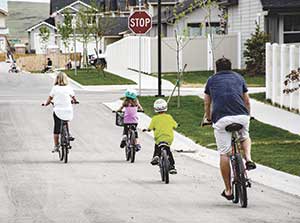
By Emmanuel Vincent
The Somerville Bike Advisory Committee held a meeting last Thursday. Held monthly, data was examined and discussed during the duration of the event.
One of the items on the agenda was bike count, done throughout the city. This is critical because it plays a role in taking the necessary steps in keeping cyclists safe. “The individual counts have had some variability, but in aggregate we’ve found the bicycle and pedestrian counts useful for understanding where a lot of people are walking and biking where safer infrastructure is most needed,” explained Tom Lamar, Chairman of the Somerville Bicycle Advisory Committee.
“For example, counts from a few years ago showed a high volume of bike traffic on Webster Ave., despite it being a gap in the bike network. This made improving Webster Ave. a priority, and after a community led process, the city installed protected bike lanes and higher visibility crosswalks,” said Lamar.
This count is vital as there is a correlation between cyclists and pedestrians. Data gathered shows that there has been an increase of pedestrians in areas such as the Community Path and Buena Vista Rd., as well as Park Street and Somerville Ave.
Another item on the agenda was a survey conducted by Livable Streets. The 20-page report, which can be found online at livablestreets.info, examines how and when buses and bikes should copy the same space, in the effort for a safe traveling experience.
While the roads can feel congested for some using bicycles as their main mode of transportation, the MBTA does an excellent job at preparing their drivers to be focused as well a cautious while operating the buses.
“MBTA bus drivers are less distracted than regular drivers and have more training,” says Kristiana Lachiusa, Commuity Engagement Manager for LivableStreets Alliance. “They generally do a better job in terms of keeping people safe and comfortable in the lanes.”
Based on the data gathered, it was determined that most successful bus-links are the ones that enhanced the bus traveling conditions for both groups. In addition, shared bus-bike lanes should be placed on constrained corridors, where separated bus and bike infrastructure is not feasible.
Feedback from the community is pivotal as it serves as a solid foundation in an effort to make them feel comfortable while navigating the streets. “A lot of safe street planning starts with analyzing counts and the overall street network, combined with specific experience of neighbors who bike to get the details,” according to Lamar. “A good example is the bus lanes on Broadway, where the community is pointed out that bikes going downhill could safely share a lane with buses, but going uphill the speeds are too different.”
The end goal is to make sure that everyone biking as a means of transportation within the city feels like that they too have the right to be a part of the road, just as buses and automobiles do. These crucial steps by the committee will certainly do just that.















Reader Comments